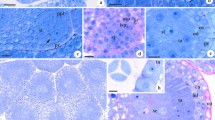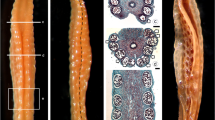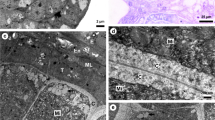Abstract
Similarities (features of the family Crassulaceae) and differences in anther development and structure were observed between Aeonium balsamiferum and A. ciliatum. Microsporangia are rounded in A. ciliatum and elongate oval in A. balsamiferum. The septum between microsporangia is consequently longer in A. ciliatum and extremely short in A. balsamiferum. In the latter, pollen can spill out through both the stomium and the apical pore (the phenomenon first discovered in the family Crassulaceae), and both modes of theca opening occur simultaneously, suggesting a greater specialization for pollination for the A. balsamiferum anther. The outer tapetum is single-layered in both species, but its cells are mononuclear in A. ciliatum and binuclear in A. balsamiferum. The inner tapetum is usually single-layered and irregularly two-layered in rare cases; its cells increase in size by a factor of 2 in A. ciliatum and 3–4 in A. balsamiferum (resembling papilloid cells in structure in the latter). Similarities in anther structure were observed between the genera Aeonium and Sedum. In both genera, the anther was isobilateral (on a transverse section) and had an epiconnective, a four-beamed connective, and an annular fibrous layer on the inner side of the connective in the lower region, where there is no fusion of the anther and filament; pollen grains were of the same structural type: tricolporate with a striated surface. The findings were consistent with the cladistic reconstructions that put species of the polyphyletic genus Sedum in the tribes Aeonieae, Semperviveae, and Sedeae. Aeonium balsamiferum and A. ciliatum fall into the Aeonium clade and occupy an intermediate position between the Telephium clade (Sedum kamtschaticum) and the Acre clade (S. palmeri).












Similar content being viewed by others
REFERENCES
Anisimova, G.M., Anther structure, microsporogenesis, and pollen grain in Kalanchoe nyikae (Crassulaceae), Bot. Zh., 2016, vol. 101, no. 12, pp. 1378–1389.
Anisimova, G.M., Anther development and structure in Sedum kamtschaticum and Sedum palmeri (Crassulaceae), Bot. Zh., 2020, vol. 105, no. 11, pp. 1093–1110. https://doi.org/10.31857/S0006813620090021
Anisimova, G.M. and Shamrov, I.I., Gynoecium and ovule morphogenesis in Kalanchoe laxiflora and K. tubiflora (Crassulaceae), Bot. Zh., 2018, vol. 103, no. 6, pp. 675–694. https://doi.org/10.1134/S0006813618060017
Anisimova, G.M. and Shamrov I.I., Gynoecium and ovule structure in Sedum kamtschaticum and Sedum palmeri (Crassulaceae), Bot. Zh., 2021, vol, 106, no. 4, pp. 363–381. https://doi.org/10.31857/S000681362104002
Anisimova, G.M. and Shamrov, I.I., Comparative analysis of gynoecium and ovule structure in some species of Sedum and Kalanchoe (Crassulaceae), Bull. Main Bot. Gard., 2021, vol. 4, pp. 31–39. https://doi.org/10.25791/BBGRAN.04.2021.1097
Davis, G.L., Systematic Embryology of Angiosperms, New York, 1966.
Goncharova, S.B., Ochitkovye (Sedoideae, Crassulaceae) flory Rossiiskogo Dal’nego Vostoka (Subfamily Sedoideae (Crassulaceae) of Flora of the Russian Far East), Vladivostok, 2006.
Goncharova, S.B. and Goncharov, A.A., Molecular phylogeny and systematics of flowering plants from family Crassulaceae DC., Mol. Biol., 2009, vol. 43, art. ID 794.
Grigorieva, V.V. and Britski, D.A., Pollen morphology of representatives of subfamily Sedoideae (Crassulaceae), Materialy XIII Rossiiskoi palinologicheskoi konferentsii “Problemy sovremennoi palinologii” (Proc. XIIIth Russ. Palynol. Conf. “Problems of Modern Palynology”), Syktyvkar, 2001, vol. 1, pp. 22–25.
Ham, R.C.H.J., Phylogenetic relationships in the Crassulaceae inferred from chloroplast DNA variation. Chapter 2, in Evolution and Systematics of the Crassulaceae, t’Hart, H. and Eggli, U., Eds., Leiden, 1995, pp. 16–29.
Ham, R.C.H.J. and t’Hart, H., Phylogenetic relationships in the Crassulaceae inferred from chloroplast DNA restriction-site variation, Am. J. Bot., 1998, vol. 85, pp. 123–134.
Hart, H., The pollen morphology of 24 species of the genus Sedum L., Pollen Spores, 1974, vol. 16, no. 4, pp. 373–387.
Kamelina, O.P., Sistematicheskaya embriologiya tsvetkovykh rastenii. Dvudol’nye (Systematic Embryology of Flowering Plants. Dicotyledons), Barnaul, 2009.
Mes, T.H.M., van Brederode, J., and ‘t Hart, H., Origin of the woody Macaronesian Sempervivoideae and the phylogenetic position of the East African species of Aeonium, Bot. Acta, 1996, vol. 109, pp. 477–491.
Mes, T.H.M., Wijers, G.-J., and 't Hart, H., Phylogenetic relationships in Monanthes (Crassulaceae) based on morphological, chloroplast, and nuclear DNA variation, J. Evol. Biol., 1997, vol. 10, pp. 193–216. https://doi.org/10.1046/j.1420-9101.1997.10020193.x
Mort, M.E., Soltis, D.E., Soltis, P.S., Francisco-Ortega, J., and Santos-Guerra, A., Phylogenetic relationships and evolution of Crassulaceae inferred from matK sequence data, Am. J. Bot., 2001, vol. 88, no. 1, pp. 76–91.
Mort, M.E., O’Leary, T.R., Carrillo-Reyes, P., Nowell, T., Archibald, J.K., and Randle, Ch.P., Phylogeny and evolution of Crassulaceae: Past, present, and future, Biodiversity Ecol., 2010, vol. 3, pp. 69–86.
Nikiticheva, Z.I., Crassulaceae family, in Sravnitel’naya embriologiya tsvetkovykh rastenii. Brunneliaceae–Tremandraceae (Comparative Embryology of Flowering Plants. Brunneliaceae–Tremandraceae), Leningrad, 1985, pp. 29–34.
Nikulin, V.Yu., Phylogenetic connections in Sedum L. (Crassulaceae J. St.-Hil.) and related genera on the basis of comparison of nucleotid sequence of nuclear and chloroplast DNA, Cand. Sci. (Biol.) Dissertation, Vladivostok, 2017.
Nikulin, V.Yu. and Gontcharov, A.A., Molecular-phylogenetic characterization of Sedum (Crassulaceae) and closely related genera based on cpDNA gene matK and its rDNA sequence comparisons, Bot. Zh., 2017, vol. 102, no. 3, pp. 309–328.
Pausheva, Z.P., Praktikum po tsitologii rastenii (Practical Work on Plant Cytology), Moscow, 1974.
Shamrov, I.I., Formation of sporangia in higher plants, Bot. Zh., 2008, vol. 93, no. 12, pp. 1817–1845.
Shamrov, I.I., Anisimova, G.M., and Babro, A.A., Formation of anther microsporangium wall, and typification of tapetum in angiosperms, Bot. Zh., 2019, vol. 104, no. 7, pp. 1001–1032. https://doi.org/10.1134/S0006813619070093
Shamrov, I.I., Anisimova, G.M., and Babro, A.A., Early stages of anther development in flowering plants, Bot. Pacifica., J. Plant Sci. Conserv., 2020, vol. 9, no. 2, pp. 1–10.
Shamrov, I.I., Anisimova, G.M., and Babro, A.A., Tapetum types and forms in angiosperms, Proc. Latv. Acad. Sci., Sect. B, 2021, vol. 75, no. 3, pp. 167–179.
Sin, J.-H., Yoo, Y.-G., and Park, K.-R., A palynotaxonomic studies of Korean Crassulaceae, Korean J. Electron Microsc., 2002, vol. 32, no. 4, pp. 345–360.
Teryokhin, E.S., Batygina, T.B., and Shamrov, I.I., New approach to classifying modes of microsporangium wall formation, in Embryology of Flowering Plants. Terminology and Concepts, Enfield: Sci. Publ., 2002, vol. 1, pp. 32–39.
Zhinkina, N.A., Evdokimova, E.E., and Shamrov, I.I., Specific anther structure in Codonopsis clematidea (Campanulaceae), Bot. Zh., 2022, vol. 107, no. 3, pp. 287–301. https://doi.org/10.31857/S0006813621120115
ACKNOWLEDGMENTS
We are grateful to E.D. Petrova and E.L. Romanova for material collection and valuable advice.
Funding
This work was supported by state contracts with the Komarov Botanical Institute (project nos. AAAA-A18-118031690084-9 “Structural and Functional Basis of Development and Adaptation in Higher Plants” and AAAA-A18-118051590112-8 “Multiple Variants of Morphogenetic Developmental Programs of Plant Reproductive Organs and Natural and Artificial Models of Their Execution”; material collection and processing and discussion of the results) and Herzen Russian State Pedagogical University (project no. 34.29.01 “Study and Conservation of Plant Biological Diversity”; description of study results).
Author information
Authors and Affiliations
Corresponding authors
Ethics declarations
Conflict of interests. The authors declare that they have no conflict of interest.
This article does not contain any studies involving animals or human subjects performed by any of the authors.
Additional information
Translated by T. Tkacheva
Rights and permissions
About this article
Cite this article
Anisimova, G.M., Shamrov, I.I. Anther Wall Formation in Aeonium balsamiferum and A. ciliatum (Crassulaceae). Dokl Biol Sci 506, 160–171 (2022). https://doi.org/10.1134/S0012496622050027
Received:
Revised:
Accepted:
Published:
Issue Date:
DOI: https://doi.org/10.1134/S0012496622050027




